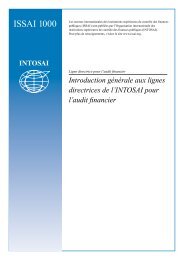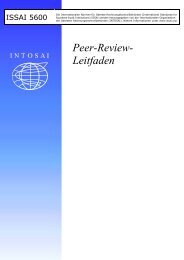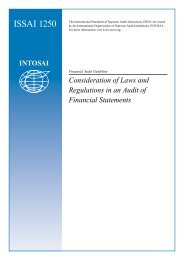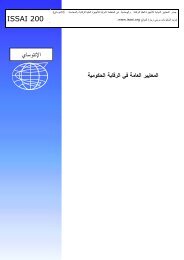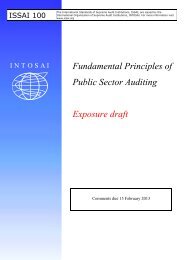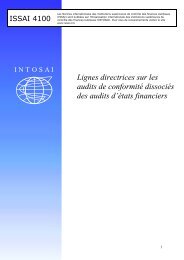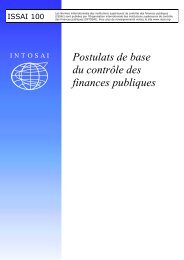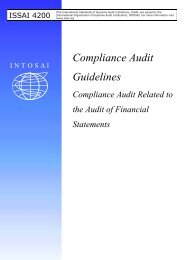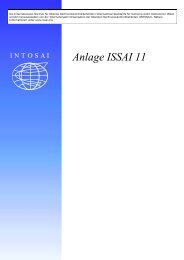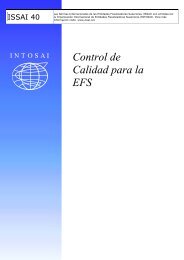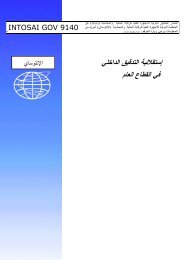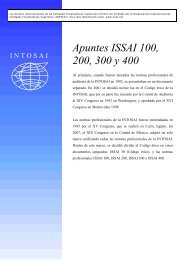Materiality in Planning and Performing an Audit - ISSAI
Materiality in Planning and Performing an Audit - ISSAI
Materiality in Planning and Performing an Audit - ISSAI
Create successful ePaper yourself
Turn your PDF publications into a flip-book with our unique Google optimized e-Paper software.
<strong>ISSAI</strong> 1320The International St<strong><strong>an</strong>d</strong>ards of Supreme <strong>Audit</strong> Institutions, <strong>ISSAI</strong>, are issuedby the International Org<strong>an</strong>ization of Supreme <strong>Audit</strong> Institutions, INTOSAI.For more <strong>in</strong>formation visit www.issai.org.F<strong>in</strong><strong>an</strong>cial <strong>Audit</strong> Guidel<strong>in</strong>e<strong>Materiality</strong> <strong>in</strong> Pl<strong>an</strong>n<strong>in</strong>g <strong><strong>an</strong>d</strong>Perform<strong>in</strong>g <strong>an</strong> <strong>Audit</strong>
<strong>ISSAI</strong> 1320INTOSAI Professional St<strong><strong>an</strong>d</strong>ards CommitteeF<strong>in</strong><strong>an</strong>cial <strong>Audit</strong> subcommittee-SecretariatRiksrevisionen • 114 90 Stockholm • SwedenTel.:+46 5171 4000 • Fax:+46 5171 4111 • E-mail: projectsecretariat@riksrevisionen.seINTOSAI General Secretariat - RECHNUNGSHOF(Austri<strong>an</strong> Court of <strong>Audit</strong>)DAMPFSCHIFFSTRASSE 2A-1033 VIENNAAUSTRIATel: ++43 (1) 711 71Fax: ++43 (1) 718 09 69<strong>in</strong>tosai@rechnungshof.gv.athttp://www.<strong>in</strong>tosai.orgThis F<strong>in</strong><strong>an</strong>cial <strong>Audit</strong> Guidel<strong>in</strong>e draws on International St<strong><strong>an</strong>d</strong>ard on <strong>Audit</strong><strong>in</strong>g (ISA) 320 “<strong>Materiality</strong> <strong>in</strong>Pl<strong>an</strong>n<strong>in</strong>g <strong><strong>an</strong>d</strong> Perform<strong>in</strong>g <strong>an</strong> <strong>Audit</strong>” developed by the International <strong>Audit</strong><strong>in</strong>g <strong><strong>an</strong>d</strong> Assur<strong>an</strong>ce St<strong><strong>an</strong>d</strong>ards Board(IAASB) <strong><strong>an</strong>d</strong> published by the International Federation of Account<strong>an</strong>ts (IFAC). The ISA is <strong>in</strong>cluded <strong>in</strong> thisGuidel<strong>in</strong>e with the permission of IFAC.450 <strong>Materiality</strong> <strong>in</strong> Pl<strong>an</strong>n<strong>in</strong>g <strong><strong>an</strong>d</strong> Perform<strong>in</strong>g <strong>an</strong> <strong>Audit</strong>
<strong>ISSAI</strong> 1320Table of Contents <strong>ISSAI</strong> 1320Practice Note TO ISA 320BackgroundIntroduction to the ISAContent of the Practice NoteApplicability of the ISA <strong>in</strong> Public Sector <strong>Audit</strong><strong>in</strong>gAdditional Guid<strong>an</strong>ce on Public Sector IssuesOverall Considerations<strong>Materiality</strong> <strong>in</strong> the Context of <strong>an</strong> <strong>Audit</strong>Determ<strong>in</strong><strong>in</strong>g <strong>Materiality</strong> <strong><strong>an</strong>d</strong> Perform<strong>an</strong>ce <strong>Materiality</strong> When Pl<strong>an</strong>n<strong>in</strong>g the <strong>Audit</strong>Revision as the <strong>Audit</strong> ProgressesParagraphP1P2P3P4P5–P7P8–P11P12International St<strong><strong>an</strong>d</strong>ard on <strong>Audit</strong><strong>in</strong>g 320IntroductionScope of this ISA 1<strong>Materiality</strong> <strong>in</strong> the Context of <strong>an</strong> <strong>Audit</strong> 2–6Effective Date 7Objective 8Def<strong>in</strong>ition 9RequirementsDeterm<strong>in</strong><strong>in</strong>g <strong>Materiality</strong> <strong><strong>an</strong>d</strong> Perform<strong>an</strong>ce <strong>Materiality</strong> When Pl<strong>an</strong>n<strong>in</strong>g the <strong>Audit</strong> 10–11Revision as the <strong>Audit</strong> Progresses 12–13Documentation 14Application <strong><strong>an</strong>d</strong> Other Expl<strong>an</strong>atory Material<strong>Materiality</strong> <strong><strong>an</strong>d</strong> <strong>Audit</strong> RiskDeterm<strong>in</strong><strong>in</strong>g <strong>Materiality</strong> <strong><strong>an</strong>d</strong> Perform<strong>an</strong>ce <strong>Materiality</strong> When Pl<strong>an</strong>n<strong>in</strong>g the <strong>Audit</strong>Revision as the <strong>Audit</strong> ProgressesA1A2–A12A13<strong>Materiality</strong> <strong>in</strong> Pl<strong>an</strong>n<strong>in</strong>g <strong><strong>an</strong>d</strong> Perform<strong>in</strong>g <strong>an</strong> <strong>Audit</strong> 451
<strong>ISSAI</strong> 1320452 <strong>Materiality</strong> <strong>in</strong> Pl<strong>an</strong>n<strong>in</strong>g <strong><strong>an</strong>d</strong> Perform<strong>in</strong>g <strong>an</strong> <strong>Audit</strong>
<strong>ISSAI</strong> 1320practice note 320Practice Note 1 to International St<strong><strong>an</strong>d</strong>ard on <strong>Audit</strong><strong>in</strong>g (ISA) 320<strong>Materiality</strong> <strong>in</strong> Pl<strong>an</strong>n<strong>in</strong>g <strong><strong>an</strong>d</strong>Perform<strong>in</strong>g <strong>an</strong> <strong>Audit</strong>BackgroundThis Practice Note provides supplementary guid<strong>an</strong>ce to public sector auditors on ISA 320 – <strong>Materiality</strong><strong>in</strong> Pl<strong>an</strong>n<strong>in</strong>g <strong><strong>an</strong>d</strong> Perform<strong>in</strong>g <strong>an</strong> <strong>Audit</strong>. It is read together with the ISA. ISA 320 is effective for audits off<strong>in</strong><strong>an</strong>cial statements for periods beg<strong>in</strong>n<strong>in</strong>g on or after December 15, 2009. The Practice Note is effectivethe same date as the ISA.Introduction to the ISAISA 320 deals with the auditor’s responsibility to apply the concept of materiality <strong>in</strong> pl<strong>an</strong>n<strong>in</strong>g <strong><strong>an</strong>d</strong>perform<strong>in</strong>g <strong>an</strong> audit of f<strong>in</strong><strong>an</strong>cial statements. ISA 450 2 expla<strong>in</strong>s how materiality is applied <strong>in</strong>evaluat<strong>in</strong>g the effect of identified misstatements on the audit <strong><strong>an</strong>d</strong> of uncorrected misstatements,if <strong>an</strong>y, on the f<strong>in</strong><strong>an</strong>cial statements.Content of the Practice NoteP1. The Practice Note provides additional guid<strong>an</strong>ce for public sector auditors related to:(a) Overall Considerations.(b) <strong>Materiality</strong> <strong>in</strong> the Context of <strong>an</strong> <strong>Audit</strong>.(c) Determ<strong>in</strong><strong>in</strong>g <strong>Materiality</strong> <strong><strong>an</strong>d</strong> Perform<strong>an</strong>ce materiality when Pl<strong>an</strong>n<strong>in</strong>g the <strong>Audit</strong>.(d) Revision as the <strong>Audit</strong> Progresses.Applicability of the ISA <strong>in</strong> Public Sector <strong>Audit</strong><strong>in</strong>gP2. ISA 320 is applicable to auditors of public sector entities <strong>in</strong> their role as auditors of f<strong>in</strong><strong>an</strong>cialstatements.Additional Guid<strong>an</strong>ce on Public Sector IssuesP3. ISA 320 conta<strong>in</strong>s application <strong><strong>an</strong>d</strong> other expl<strong>an</strong>atory material with considerations specific topublic sector entities <strong>in</strong> paragraphs A2 <strong><strong>an</strong>d</strong> A9 of the ISA.1 All Practice Notes are considered together with <strong>ISSAI</strong> 1000 “General Introduction to the INTOSAI F<strong>in</strong><strong>an</strong>cial <strong>Audit</strong> Guidel<strong>in</strong>es.”2 ISA 450, “Evaluation of Misstatements Identified dur<strong>in</strong>g the <strong>Audit</strong>.”<strong>Materiality</strong> <strong>in</strong> Pl<strong>an</strong>n<strong>in</strong>g <strong><strong>an</strong>d</strong> Perform<strong>in</strong>g <strong>an</strong> <strong>Audit</strong> 453
<strong>ISSAI</strong> 1320practice note 320Overall ConsiderationsP4. The objectives of a f<strong>in</strong><strong>an</strong>cial audit <strong>in</strong> the public sector are often broader th<strong>an</strong> the scope of theISAs, which <strong>in</strong>volves report<strong>in</strong>g whether the f<strong>in</strong><strong>an</strong>cial statements have been prepared, <strong>in</strong> allmaterial respects, <strong>in</strong> accord<strong>an</strong>ce with the applicable f<strong>in</strong><strong>an</strong>cial report<strong>in</strong>g framework (i.e. the scopeof the ISAs). The audit m<strong><strong>an</strong>d</strong>ate may also result <strong>in</strong> additional objectives considered related to theaudit of f<strong>in</strong><strong>an</strong>cial statements. These objectives may <strong>in</strong>clude additional audit <strong><strong>an</strong>d</strong> report<strong>in</strong>g responsibilities,for example, relat<strong>in</strong>g to report<strong>in</strong>g whether the auditor found <strong>an</strong>y <strong>in</strong>st<strong>an</strong>ces of non-compli<strong>an</strong>cewith authorities <strong>in</strong>clud<strong>in</strong>g budget <strong><strong>an</strong>d</strong> accountability <strong><strong>an</strong>d</strong>/or report<strong>in</strong>g on the effectivenessof <strong>in</strong>ternal control. Even <strong>in</strong> cases where there are no such additional report<strong>in</strong>g objectives, theremay be general public expectations <strong>in</strong> regard to public sector auditors’ report<strong>in</strong>g of non-compli<strong>an</strong>cewith authorities or report<strong>in</strong>g on the effectiveness of <strong>in</strong>ternal control. Therefore, public sectorauditors keep such expectations <strong>in</strong> m<strong>in</strong>d when determ<strong>in</strong><strong>in</strong>g materiality. Additional responsibilitiesrelated to compli<strong>an</strong>ce with authorities, are dealt with <strong>in</strong> the INTOSAI Compli<strong>an</strong>ce <strong>Audit</strong> Guidel<strong>in</strong>es(<strong>ISSAI</strong> 4000 3 <strong><strong>an</strong>d</strong> 4200 4 ). Public sector auditors with such additional responsibilities mayconsider <strong>ISSAI</strong>s 4000 <strong><strong>an</strong>d</strong> 4200.<strong>Materiality</strong> <strong>in</strong> the Context of <strong>an</strong> <strong>Audit</strong>P5. When determ<strong>in</strong><strong>in</strong>g materiality for pl<strong>an</strong>n<strong>in</strong>g purposes <strong>in</strong> the public sector both qu<strong>an</strong>titative <strong><strong>an</strong>d</strong>qualitative matters as well as the nature of items are of import<strong>an</strong>ce. The context <strong>in</strong> which the matterappears may be of import<strong>an</strong>ce. Furthermore, the <strong>in</strong>herent nature or characteristics of items, orgroups of items, may render them material.P6. Paragraph A2 of ISA 320 states that the legislators <strong><strong>an</strong>d</strong> regulators are often the primary users ofthe public sector entities’ f<strong>in</strong><strong>an</strong>cial statements, <strong><strong>an</strong>d</strong> that the f<strong>in</strong><strong>an</strong>cial statements may be used tomake decisions other th<strong>an</strong> economic ones. Legislators represent the citizens <strong><strong>an</strong>d</strong> provide fund<strong>in</strong>gfor various government programs, activities, <strong><strong>an</strong>d</strong> functions. Legislators <strong><strong>an</strong>d</strong>/or regulatorsfrequently evaluate or make decisions about <strong>an</strong> entity’s activities. Other users may <strong>in</strong>clude entitym<strong>an</strong>agement, bondholders or the media. F<strong>in</strong><strong>an</strong>cial statements that meet the needs of legislators<strong><strong>an</strong>d</strong> regulators will also meet most of the needs of other users.P7. The f<strong>in</strong><strong>an</strong>cial statements may also represent a key element of a public sector entity’s accountabilityto the public. The accountability framework may <strong>in</strong>troduce other factors that <strong>in</strong>fluencethe determ<strong>in</strong>ation of materiality at different levels. As a consequence, materiality is likely to be aresult of both qu<strong>an</strong>titative <strong><strong>an</strong>d</strong> qualitative factors, <strong><strong>an</strong>d</strong> materiality levels for particular classes oftr<strong>an</strong>sactions, account bal<strong>an</strong>ces <strong><strong>an</strong>d</strong> disclosures may therefore often be set at a low level.3 <strong>ISSAI</strong> 4000, “General Introduction to Guidel<strong>in</strong>es on Compli<strong>an</strong>ce <strong>Audit</strong>.”4 <strong>ISSAI</strong> 4200, “Compli<strong>an</strong>ce <strong>Audit</strong> Guidel<strong>in</strong>es Related to <strong>Audit</strong> of F<strong>in</strong><strong>an</strong>cial Statements.”454 <strong>Materiality</strong> <strong>in</strong> Pl<strong>an</strong>n<strong>in</strong>g <strong><strong>an</strong>d</strong> Perform<strong>in</strong>g <strong>an</strong> <strong>Audit</strong>
<strong>ISSAI</strong> 1320practice note 320Determ<strong>in</strong><strong>in</strong>g <strong>Materiality</strong> <strong><strong>an</strong>d</strong> Perform<strong>an</strong>ce <strong>Materiality</strong> When Pl<strong>an</strong>n<strong>in</strong>gthe <strong>Audit</strong>P8. As noted above, materiality <strong>in</strong> the public sector <strong>in</strong>cludes both qu<strong>an</strong>titative <strong><strong>an</strong>d</strong> qualitative aspects(referred to <strong>in</strong> the ISAs as aspects related to the “size” <strong><strong>an</strong>d</strong> “nature” of misstatements). The determ<strong>in</strong>ationof a materiality level or levels is described <strong>in</strong> paragraphs 10 <strong><strong>an</strong>d</strong> 11 of the ISA. In thepublic sector, materiality levels for classes of tr<strong>an</strong>sactions, account bal<strong>an</strong>ces or disclosures maybe set at a lower level th<strong>an</strong> the materiality levels that would be derived by follow<strong>in</strong>g the requirementsof the ISA. This may be for a variety of reasons, <strong>in</strong>clud<strong>in</strong>g the context of the matter, or thenature <strong><strong>an</strong>d</strong> characteristics of the systems <strong><strong>an</strong>d</strong> entities <strong>in</strong>volved as expla<strong>in</strong>ed <strong>in</strong> paragraphs P5 – P7above. Furthermore, certa<strong>in</strong> procedures may be required to be performed by audit m<strong><strong>an</strong>d</strong>ate orlegislation. Examples of such procedures might be tests of m<strong>in</strong>isterial salaries regulated by statute<strong><strong>an</strong>d</strong> sensitive payments such as travel <strong><strong>an</strong>d</strong> hospitality of senior staff. In the rare cases wherethe public sector auditors w<strong>an</strong>t to detect all such misstatements, they test all relev<strong>an</strong>t tr<strong>an</strong>sactions.P9. Where public sector auditors also provide op<strong>in</strong>ions on the effectiveness of controls or compli<strong>an</strong>cewith laws <strong><strong>an</strong>d</strong> regulations they consider the need to establish materiality for these objectives <strong>in</strong>addition to materiality for the f<strong>in</strong><strong>an</strong>cial statements. For example, when report<strong>in</strong>g on the effectivenessof controls, the auditor may use a benchmark based on the percentage of tr<strong>an</strong>sactions ormonetary amounts sampled to determ<strong>in</strong>e materiality for evaluat<strong>in</strong>g control deviations.P10. Paragraph A2 of the ISA describes considerations specific to determ<strong>in</strong><strong>in</strong>g materiality levels <strong>in</strong>the public sector. When determ<strong>in</strong><strong>in</strong>g whether a particular class of tr<strong>an</strong>sactions, account bal<strong>an</strong>ce,disclosure, or other assertion which is part of the f<strong>in</strong><strong>an</strong>cial report<strong>in</strong>g framework, is material byvirtue of its nature, public sector auditors take <strong>in</strong>to account qualitative aspects such as:• The context <strong>in</strong> which the matter appears, for example if the matter is also subject to compli<strong>an</strong>cewith authorities, legislation or regulations, or if law or regulation prohibits overspend<strong>in</strong>g ofpublic funds, regardless of the amounts <strong>in</strong>volved;• The needs of the various stakeholders <strong><strong>an</strong>d</strong> how they use the f<strong>in</strong><strong>an</strong>cial statements;• The nature of the tr<strong>an</strong>sactions that are considered sensitive to users of the f<strong>in</strong><strong>an</strong>cial statements;• Public expectations <strong><strong>an</strong>d</strong> public <strong>in</strong>terest, <strong>in</strong>clud<strong>in</strong>g emphasis placed on the particular matterby relev<strong>an</strong>t committees <strong>in</strong> the legislature, such as a public accounts committee, <strong>in</strong>clud<strong>in</strong>g thenecessity of certa<strong>in</strong> disclosures;• The need for legislative oversight <strong><strong>an</strong>d</strong> regulation <strong>in</strong> a particular area; <strong><strong>an</strong>d</strong>• The need for openness <strong><strong>an</strong>d</strong> tr<strong>an</strong>sparency, for example if there are particular disclosure requirementsfor frauds or other losses.P11. Paragraph A9 of the ISA discusses identify<strong>in</strong>g appropriate benchmarks for f<strong>in</strong><strong>an</strong>cial statementmateriality. For public sector entities that are expected to recover costs or break-even, net costs maynot be <strong>an</strong> appropriate benchmark. In those cases gross expenditure or gross revenues may be a morerelev<strong>an</strong>t benchmark. For public sector entities that are custodi<strong>an</strong>s of large amounts of assets, totalassets, total liabilities, net assets or net liabilities or certa<strong>in</strong> classes of assets might be <strong>an</strong> appropriatebenchmark if they are accounted for <strong>in</strong> the f<strong>in</strong><strong>an</strong>cial statements. In some cases, especially whenconsider<strong>in</strong>g qualitative materiality, other types of benchmarks may also be useful. For example:• The number of users or entities affected as a percentage of total users or entities <strong>in</strong>volved <strong>in</strong> theparticular program;<strong>Materiality</strong> <strong>in</strong> Pl<strong>an</strong>n<strong>in</strong>g <strong><strong>an</strong>d</strong> Perform<strong>in</strong>g <strong>an</strong> <strong>Audit</strong> 455
<strong>ISSAI</strong> 1320practice note 320• Those amounts previously considered material by a relev<strong>an</strong>t committee <strong>in</strong> the legislature, suchas public accounts committee; <strong><strong>an</strong>d</strong>• Benefit payments as compared to cost of liv<strong>in</strong>g <strong>in</strong>dicators, for example the import<strong>an</strong>ce to theeligible recipient of monthly benefit payments, such as retirement or disability, paid out <strong>in</strong> accord<strong>an</strong>cewith public sector programs.Revision as the <strong>Audit</strong> ProgressesP12. Paragraphs 12, 13 <strong><strong>an</strong>d</strong> A13 of the ISA discuss the need to revise materiality levels <strong>in</strong> the event ofbecom<strong>in</strong>g aware of new <strong>in</strong>formation dur<strong>in</strong>g the course of the audit. Due to govern<strong>an</strong>ce structures<strong><strong>an</strong>d</strong> <strong>in</strong>terrelationships of entities with<strong>in</strong> the public sector, it is not unusual for public sector auditorsto receive new <strong>in</strong>formation dur<strong>in</strong>g the course of the audit.456 <strong>Materiality</strong> <strong>in</strong> Pl<strong>an</strong>n<strong>in</strong>g <strong><strong>an</strong>d</strong> Perform<strong>in</strong>g <strong>an</strong> <strong>Audit</strong>
International<strong>Audit</strong><strong>in</strong>g <strong><strong>an</strong>d</strong>Assur<strong>an</strong>ceSt<strong><strong>an</strong>d</strong>ardsBoardISA 320April 2009International St<strong><strong>an</strong>d</strong>ard on <strong>Audit</strong><strong>in</strong>g<strong>Materiality</strong> <strong>in</strong> Pl<strong>an</strong>n<strong>in</strong>g <strong><strong>an</strong>d</strong>Perform<strong>in</strong>g <strong>an</strong> <strong>Audit</strong>
<strong>ISSAI</strong> 1320ISA 320International <strong>Audit</strong><strong>in</strong>g <strong><strong>an</strong>d</strong> Assur<strong>an</strong>ce St<strong><strong>an</strong>d</strong>ards BoardInternational Federation of Account<strong>an</strong>ts545 Fifth Avenue, 14 th FloorNew York, New York 10017 USAThis International St<strong><strong>an</strong>d</strong>ard on <strong>Audit</strong><strong>in</strong>g (ISA) 320, “<strong>Materiality</strong> <strong>in</strong> Pl<strong>an</strong>n<strong>in</strong>g <strong><strong>an</strong>d</strong>Peform<strong>in</strong>g <strong>an</strong> <strong>Audit</strong>” was prepared by the International <strong>Audit</strong><strong>in</strong>g <strong><strong>an</strong>d</strong> Assur<strong>an</strong>ceSt<strong><strong>an</strong>d</strong>ards Board (IAASB), <strong>an</strong> <strong>in</strong>dependent st<strong><strong>an</strong>d</strong>ard-sett<strong>in</strong>g body with<strong>in</strong> theInternational Federation of Account<strong>an</strong>ts (IFAC). The objective of the IAASB is to servethe public <strong>in</strong>terest by sett<strong>in</strong>g high quality audit<strong>in</strong>g <strong><strong>an</strong>d</strong> assur<strong>an</strong>ce st<strong><strong>an</strong>d</strong>ards <strong><strong>an</strong>d</strong> byfacilitat<strong>in</strong>g the convergence of <strong>in</strong>ternational <strong><strong>an</strong>d</strong> national st<strong><strong>an</strong>d</strong>ards, thereby enh<strong>an</strong>c<strong>in</strong>gthe quality <strong><strong>an</strong>d</strong> uniformity of practice throughout the world <strong><strong>an</strong>d</strong> strengthen<strong>in</strong>g publicconfidence <strong>in</strong> the global audit<strong>in</strong>g <strong><strong>an</strong>d</strong> assur<strong>an</strong>ce profession.This publication may be downloaded free of charge from the IFAC website:http://www.ifac.org. The approved text is published <strong>in</strong> the English l<strong>an</strong>guage.The mission of IFAC is to serve the public <strong>in</strong>terest, strengthen the worldwideaccount<strong>an</strong>cy profession <strong><strong>an</strong>d</strong> contribute to the development of strong <strong>in</strong>ternationaleconomies by establish<strong>in</strong>g <strong><strong>an</strong>d</strong> promot<strong>in</strong>g adherence to high quality professionalst<strong><strong>an</strong>d</strong>ards, further<strong>in</strong>g the <strong>in</strong>ternational convergence of such st<strong><strong>an</strong>d</strong>ards <strong><strong>an</strong>d</strong> speak<strong>in</strong>g outon public <strong>in</strong>terest issues where the profession’s expertise is most relev<strong>an</strong>t.Copyright © April 2009 by the International Federation of Account<strong>an</strong>ts (IFAC). Allrights reserved. Permission is gr<strong>an</strong>ted to make copies of this work provided that suchcopies are for use <strong>in</strong> academic classrooms or for personal use <strong><strong>an</strong>d</strong> are not sold ordissem<strong>in</strong>ated <strong><strong>an</strong>d</strong> provided that each copy bears the follow<strong>in</strong>g credit l<strong>in</strong>e: “Copyright ©April 2009 by the International Federation of Account<strong>an</strong>ts (IFAC). All rights reserved.Used with permission of IFAC. Contact permissions@ifac.org for permission toreproduce, store or tr<strong>an</strong>smit this document.” Otherwise, written permission from IFACis required to reproduce, store or tr<strong>an</strong>smit, or to make other similar uses of, thisdocument, except as permitted by law. Contact permissions@ifac.org.ISBN: 978-1-60815-008-31458 <strong>Materiality</strong> <strong>in</strong> Pl<strong>an</strong>n<strong>in</strong>g <strong><strong>an</strong>d</strong> Perform<strong>in</strong>g <strong>an</strong> <strong>Audit</strong>
<strong>ISSAI</strong> 1320ISA 320IntroductionINTERNATIONAL STANDARD ON AUDITING 320MATERIALITY IN PLANNING AND PERFORMINGAN AUDIT(Effective for audits of f<strong>in</strong><strong>an</strong>cial statements for periodsbeg<strong>in</strong>n<strong>in</strong>g on or after December 15, 2009)CONTENTSParagraphScope of this ISA ........................................................................................ 1<strong>Materiality</strong> <strong>in</strong> the Context of <strong>an</strong> <strong>Audit</strong> ........................................................Effective Date ............................................................................................. 7Objective .................................................................................................... 8Def<strong>in</strong>ition ................................................................................................... 9RequirementsDeterm<strong>in</strong><strong>in</strong>g <strong>Materiality</strong> <strong><strong>an</strong>d</strong> Perform<strong>an</strong>ce <strong>Materiality</strong> When Pl<strong>an</strong>n<strong>in</strong>gthe <strong>Audit</strong> ..............................................................................................Revision as the <strong>Audit</strong> Progresses ................................................................2−610−1112−13Documentation ............................................................................................ 14Application <strong><strong>an</strong>d</strong> Other Expl<strong>an</strong>atory Material<strong>Materiality</strong> <strong><strong>an</strong>d</strong> <strong>Audit</strong> Risk ..........................................................................Determ<strong>in</strong><strong>in</strong>g <strong>Materiality</strong> <strong><strong>an</strong>d</strong> Perform<strong>an</strong>ce <strong>Materiality</strong> When Pl<strong>an</strong>n<strong>in</strong>gthe <strong>Audit</strong> ..............................................................................................Revision as the <strong>Audit</strong> Progresses ................................................................A1A2−A12A13International St<strong><strong>an</strong>d</strong>ard on <strong>Audit</strong><strong>in</strong>g (ISA) 320, “<strong>Materiality</strong> <strong>in</strong> Pl<strong>an</strong>n<strong>in</strong>g <strong><strong>an</strong>d</strong>Perform<strong>in</strong>g <strong>an</strong> <strong>Audit</strong>” should be read <strong>in</strong> the context of ISA 200, “Overall Objectivesof the Independent <strong>Audit</strong>or <strong><strong>an</strong>d</strong> the Conduct of <strong>an</strong> <strong>Audit</strong> <strong>in</strong> Accord<strong>an</strong>ce withInternational St<strong><strong>an</strong>d</strong>ards on <strong>Audit</strong><strong>in</strong>g.”2<strong>Materiality</strong> <strong>in</strong> Pl<strong>an</strong>n<strong>in</strong>g <strong><strong>an</strong>d</strong> Perform<strong>in</strong>g <strong>an</strong> <strong>Audit</strong> 459
<strong>ISSAI</strong> 1320ISA 320MATERIALITY IN PLANNING AND PERFORMING AN AUDITIntroductionScope of this ISA1. This International St<strong><strong>an</strong>d</strong>ard on <strong>Audit</strong><strong>in</strong>g (ISA) deals with the auditor’sresponsibility to apply the concept of materiality <strong>in</strong> pl<strong>an</strong>n<strong>in</strong>g <strong><strong>an</strong>d</strong> perform<strong>in</strong>g <strong>an</strong>audit of f<strong>in</strong><strong>an</strong>cial statements. ISA 450 1 expla<strong>in</strong>s how materiality is applied <strong>in</strong>evaluat<strong>in</strong>g the effect of identified misstatements on the audit <strong><strong>an</strong>d</strong> of uncorrectedmisstatements, if <strong>an</strong>y, on the f<strong>in</strong><strong>an</strong>cial statements.<strong>Materiality</strong> <strong>in</strong> the Context of <strong>an</strong> <strong>Audit</strong>2. F<strong>in</strong><strong>an</strong>cial report<strong>in</strong>g frameworks often discuss the concept of materiality <strong>in</strong> thecontext of the preparation <strong><strong>an</strong>d</strong> presentation of f<strong>in</strong><strong>an</strong>cial statements. Althoughf<strong>in</strong><strong>an</strong>cial report<strong>in</strong>g frameworks may discuss materiality <strong>in</strong> different terms, theygenerally expla<strong>in</strong> that:• Misstatements, <strong>in</strong>clud<strong>in</strong>g omissions, are considered to be material ifthey, <strong>in</strong>dividually or <strong>in</strong> the aggregate, could reasonably be expected to<strong>in</strong>fluence the economic decisions of users taken on the basis of thef<strong>in</strong><strong>an</strong>cial statements;• Judgments about materiality are made <strong>in</strong> light of surround<strong>in</strong>gcircumst<strong>an</strong>ces, <strong><strong>an</strong>d</strong> are affected by the size or nature of a misstatement,or a comb<strong>in</strong>ation of both; <strong><strong>an</strong>d</strong>• Judgments about matters that are material to users of the f<strong>in</strong><strong>an</strong>cialstatements are based on a consideration of the common f<strong>in</strong><strong>an</strong>cial<strong>in</strong>formation needs of users as a group. 2 The possible effect ofmisstatements on specific <strong>in</strong>dividual users, whose needs may varywidely, is not considered.3. Such a discussion, if present <strong>in</strong> the applicable f<strong>in</strong><strong>an</strong>cial report<strong>in</strong>g framework,provides a frame of reference to the auditor <strong>in</strong> determ<strong>in</strong><strong>in</strong>g materiality for theaudit. If the applicable f<strong>in</strong><strong>an</strong>cial report<strong>in</strong>g framework does not <strong>in</strong>clude adiscussion of the concept of materiality, the characteristics referred to <strong>in</strong>paragraph 2 provide the auditor with such a frame of reference.4. The auditor’s determ<strong>in</strong>ation of materiality is a matter of professional judgment,<strong><strong>an</strong>d</strong> is affected by the auditor’s perception of the f<strong>in</strong><strong>an</strong>cial <strong>in</strong>formation needs of12ISA 450, “Evaluation of Misstatements Identified dur<strong>in</strong>g the <strong>Audit</strong>.”For example, the “Framework for the Preparation <strong><strong>an</strong>d</strong> Presentation of F<strong>in</strong><strong>an</strong>cial Statements,” adopted bythe International Account<strong>in</strong>g St<strong><strong>an</strong>d</strong>ards Board <strong>in</strong> April 2001, <strong>in</strong>dicates that, for a profit-oriented entity, as<strong>in</strong>vestors are providers of risk capital to the enterprise, the provision of f<strong>in</strong><strong>an</strong>cial statements that meettheir needs will also meet most of the needs of other users that f<strong>in</strong><strong>an</strong>cial statements c<strong>an</strong> satisfy.3460 <strong>Materiality</strong> <strong>in</strong> Pl<strong>an</strong>n<strong>in</strong>g <strong><strong>an</strong>d</strong> Perform<strong>in</strong>g <strong>an</strong> <strong>Audit</strong>
<strong>ISSAI</strong> 1320ISA 320MATERIALITY IN PLANNING AND PERFORMING AN AUDITusers of the f<strong>in</strong><strong>an</strong>cial statements. In this context, it is reasonable for the auditorto assume that users:(a)(b)(c)(d)Have a reasonable knowledge of bus<strong>in</strong>ess <strong><strong>an</strong>d</strong> economic activities <strong><strong>an</strong>d</strong>account<strong>in</strong>g <strong><strong>an</strong>d</strong> a will<strong>in</strong>gness to study the <strong>in</strong>formation <strong>in</strong> the f<strong>in</strong><strong>an</strong>cialstatements with reasonable diligence;Underst<strong><strong>an</strong>d</strong> that f<strong>in</strong><strong>an</strong>cial statements are prepared, presented <strong><strong>an</strong>d</strong>audited to levels of materiality;Recognize the uncerta<strong>in</strong>ties <strong>in</strong>herent <strong>in</strong> the measurement of amountsbased on the use of estimates, judgment <strong><strong>an</strong>d</strong> the consideration of futureevents; <strong><strong>an</strong>d</strong>Make reasonable economic decisions on the basis of the <strong>in</strong>formation <strong>in</strong>the f<strong>in</strong><strong>an</strong>cial statements.5. The concept of materiality is applied by the auditor both <strong>in</strong> pl<strong>an</strong>n<strong>in</strong>g <strong><strong>an</strong>d</strong>perform<strong>in</strong>g the audit, <strong><strong>an</strong>d</strong> <strong>in</strong> evaluat<strong>in</strong>g the effect of identified misstatements onthe audit <strong><strong>an</strong>d</strong> of uncorrected misstatements, if <strong>an</strong>y, on the f<strong>in</strong><strong>an</strong>cial statements<strong><strong>an</strong>d</strong> <strong>in</strong> form<strong>in</strong>g the op<strong>in</strong>ion <strong>in</strong> the auditor’s report. (Ref: Para. A1)6. In pl<strong>an</strong>n<strong>in</strong>g the audit, the auditor makes judgments about the size ofmisstatements that will be considered material. These judgments provide abasis for:(a)(b)(c)Determ<strong>in</strong><strong>in</strong>g the nature, tim<strong>in</strong>g <strong><strong>an</strong>d</strong> extent of risk assessmentprocedures;Identify<strong>in</strong>g <strong><strong>an</strong>d</strong> assess<strong>in</strong>g the risks of material misstatement; <strong><strong>an</strong>d</strong>Determ<strong>in</strong><strong>in</strong>g the nature, tim<strong>in</strong>g <strong><strong>an</strong>d</strong> extent of further audit procedures.The materiality determ<strong>in</strong>ed when pl<strong>an</strong>n<strong>in</strong>g the audit does not necessarilyestablish <strong>an</strong> amount below which uncorrected misstatements, <strong>in</strong>dividually or <strong>in</strong>the aggregate, will always be evaluated as immaterial. The circumst<strong>an</strong>cesrelated to some misstatements may cause the auditor to evaluate them asmaterial even if they are below materiality. Although it is not practicable todesign audit procedures to detect misstatements that could be material solelybecause of their nature, the auditor considers not only the size but also thenature of uncorrected misstatements, <strong><strong>an</strong>d</strong> the particular circumst<strong>an</strong>ces of theiroccurrence, when evaluat<strong>in</strong>g their effect on the f<strong>in</strong><strong>an</strong>cial statements. 33ISA 450, paragraph A16.4<strong>Materiality</strong> <strong>in</strong> Pl<strong>an</strong>n<strong>in</strong>g <strong><strong>an</strong>d</strong> Perform<strong>in</strong>g <strong>an</strong> <strong>Audit</strong> 461
<strong>ISSAI</strong> 1320ISA 320MATERIALITY IN PLANNING AND PERFORMING AN AUDITEffective Date7. This ISA is effective for audits of f<strong>in</strong><strong>an</strong>cial statements for periods beg<strong>in</strong>n<strong>in</strong>g onor after December 15, 2009.Objective8. The objective of the auditor is to apply the concept of materiality appropriately<strong>in</strong> pl<strong>an</strong>n<strong>in</strong>g <strong><strong>an</strong>d</strong> perform<strong>in</strong>g the audit.Def<strong>in</strong>ition9. For purposes of the ISAs, perform<strong>an</strong>ce materiality me<strong>an</strong>s the amount oramounts set by the auditor at less th<strong>an</strong> materiality for the f<strong>in</strong><strong>an</strong>cial statementsas a whole to reduce to <strong>an</strong> appropriately low level the probability that theaggregate of uncorrected <strong><strong>an</strong>d</strong> undetected misstatements exceeds materiality forthe f<strong>in</strong><strong>an</strong>cial statements as a whole. If applicable, perform<strong>an</strong>ce materiality alsorefers to the amount or amounts set by the auditor at less th<strong>an</strong> the materialitylevel or levels for particular classes of tr<strong>an</strong>sactions, account bal<strong>an</strong>ces ordisclosures.RequirementsDeterm<strong>in</strong><strong>in</strong>g <strong>Materiality</strong> <strong><strong>an</strong>d</strong> Perform<strong>an</strong>ce <strong>Materiality</strong> When Pl<strong>an</strong>n<strong>in</strong>g the <strong>Audit</strong>10. When establish<strong>in</strong>g the overall audit strategy, the auditor shall determ<strong>in</strong>emateriality for the f<strong>in</strong><strong>an</strong>cial statements as a whole. If, <strong>in</strong> the specificcircumst<strong>an</strong>ces of the entity, there is one or more particular classes oftr<strong>an</strong>sactions, account bal<strong>an</strong>ces or disclosures for which misstatements of lesseramounts th<strong>an</strong> materiality for the f<strong>in</strong><strong>an</strong>cial statements as a whole couldreasonably be expected to <strong>in</strong>fluence the economic decisions of users taken onthe basis of the f<strong>in</strong><strong>an</strong>cial statements, the auditor shall also determ<strong>in</strong>e themateriality level or levels to be applied to those particular classes oftr<strong>an</strong>sactions, account bal<strong>an</strong>ces or disclosures. (Ref: Para. A2-A11)11. The auditor shall determ<strong>in</strong>e perform<strong>an</strong>ce materiality for purposes of assess<strong>in</strong>gthe risks of material misstatement <strong><strong>an</strong>d</strong> determ<strong>in</strong><strong>in</strong>g the nature, tim<strong>in</strong>g <strong><strong>an</strong>d</strong>extent of further audit procedures. (Ref: Para. A12)Revision as the <strong>Audit</strong> Progresses12. The auditor shall revise materiality for the f<strong>in</strong><strong>an</strong>cial statements as a whole (<strong><strong>an</strong>d</strong>,if applicable, the materiality level or levels for particular classes oftr<strong>an</strong>sactions, account bal<strong>an</strong>ces or disclosures) <strong>in</strong> the event of becom<strong>in</strong>g awareof <strong>in</strong>formation dur<strong>in</strong>g the audit that would have caused the auditor to havedeterm<strong>in</strong>ed a different amount (or amounts) <strong>in</strong>itially. (Ref: Para. A13)13. If the auditor concludes that a lower materiality for the f<strong>in</strong><strong>an</strong>cial statements as awhole (<strong><strong>an</strong>d</strong>, if applicable, materiality level or levels for particular classes of5462 <strong>Materiality</strong> <strong>in</strong> Pl<strong>an</strong>n<strong>in</strong>g <strong><strong>an</strong>d</strong> Perform<strong>in</strong>g <strong>an</strong> <strong>Audit</strong>
<strong>ISSAI</strong> 1320ISA 320MATERIALITY IN PLANNING AND PERFORMING AN AUDITDocumentationtr<strong>an</strong>sactions, account bal<strong>an</strong>ces or disclosures) th<strong>an</strong> that <strong>in</strong>itially determ<strong>in</strong>ed isappropriate, the auditor shall determ<strong>in</strong>e whether it is necessary to reviseperform<strong>an</strong>ce materiality, <strong><strong>an</strong>d</strong> whether the nature, tim<strong>in</strong>g <strong><strong>an</strong>d</strong> extent of thefurther audit procedures rema<strong>in</strong> appropriate.14. The auditor shall <strong>in</strong>clude <strong>in</strong> the audit documentation the follow<strong>in</strong>g amounts <strong><strong>an</strong>d</strong>the factors considered <strong>in</strong> their determ<strong>in</strong>ation: 4(a) <strong>Materiality</strong> for the f<strong>in</strong><strong>an</strong>cial statements as a whole (see paragraph 10);(b)(c)If applicable, the materiality level or levels for particular classes oftr<strong>an</strong>sactions, account bal<strong>an</strong>ces or disclosures (see paragraph 10);Perform<strong>an</strong>ce materiality (see paragraph 11); <strong><strong>an</strong>d</strong>(d) Any revision of (a)-(c) as the audit progressed (see paragraphs 12-13).***Application <strong><strong>an</strong>d</strong> Other Expl<strong>an</strong>atory Material<strong>Materiality</strong> <strong><strong>an</strong>d</strong> <strong>Audit</strong> Risk (Ref: Para. 5)A1. In conduct<strong>in</strong>g <strong>an</strong> audit of f<strong>in</strong><strong>an</strong>cial statements, the overall objectives of theauditor are to obta<strong>in</strong> reasonable assur<strong>an</strong>ce about whether the f<strong>in</strong><strong>an</strong>cialstatements as a whole are free from material misstatement, whether due tofraud or error, thereby enabl<strong>in</strong>g the auditor to express <strong>an</strong> op<strong>in</strong>ion on whetherthe f<strong>in</strong><strong>an</strong>cial statements are prepared, <strong>in</strong> all material respects, <strong>in</strong> accord<strong>an</strong>cewith <strong>an</strong> applicable f<strong>in</strong><strong>an</strong>cial report<strong>in</strong>g framework; <strong><strong>an</strong>d</strong> to report on the f<strong>in</strong><strong>an</strong>cialstatements, <strong><strong>an</strong>d</strong> communicate as required by the ISAs, <strong>in</strong> accord<strong>an</strong>ce with theauditor’s f<strong>in</strong>d<strong>in</strong>gs. 5 The auditor obta<strong>in</strong>s reasonable assur<strong>an</strong>ce by obta<strong>in</strong><strong>in</strong>gsufficient appropriate audit evidence to reduce audit risk to <strong>an</strong> acceptably lowlevel. 6 <strong>Audit</strong> risk is the risk that the auditor expresses <strong>an</strong> <strong>in</strong>appropriate auditop<strong>in</strong>ion when the f<strong>in</strong><strong>an</strong>cial statements are materially misstated. <strong>Audit</strong> risk is afunction of the risks of material misstatement <strong><strong>an</strong>d</strong> detection risk. 7 <strong>Materiality</strong><strong><strong>an</strong>d</strong> audit risk are considered throughout the audit, <strong>in</strong> particular, when:4567ISA 230, “<strong>Audit</strong> Documentation,” paragraphs 8-11, <strong><strong>an</strong>d</strong> paragraph A6.ISA 200, “Overall Objectives of the Independent <strong>Audit</strong>or <strong><strong>an</strong>d</strong> the Conduct of <strong>an</strong> <strong>Audit</strong> <strong>in</strong> Accord<strong>an</strong>cewith International St<strong><strong>an</strong>d</strong>ards on <strong>Audit</strong><strong>in</strong>g,” paragraph 11.ISA 200, paragraph 17.ISA 200, paragraph 13(c).6<strong>Materiality</strong> <strong>in</strong> Pl<strong>an</strong>n<strong>in</strong>g <strong><strong>an</strong>d</strong> Perform<strong>in</strong>g <strong>an</strong> <strong>Audit</strong> 463
<strong>ISSAI</strong> 1320ISA 320MATERIALITY IN PLANNING AND PERFORMING AN AUDIT(a) Identify<strong>in</strong>g <strong><strong>an</strong>d</strong> assess<strong>in</strong>g the risks of material misstatement; 8(b) Determ<strong>in</strong><strong>in</strong>g the nature, tim<strong>in</strong>g <strong><strong>an</strong>d</strong> extent of further audit procedures; 9<strong><strong>an</strong>d</strong>(c)Evaluat<strong>in</strong>g the effect of uncorrected misstatements, if <strong>an</strong>y, on thef<strong>in</strong><strong>an</strong>cial statements 10 <strong><strong>an</strong>d</strong> <strong>in</strong> form<strong>in</strong>g the op<strong>in</strong>ion <strong>in</strong> the auditor’sreport. 11Determ<strong>in</strong><strong>in</strong>g <strong>Materiality</strong> <strong><strong>an</strong>d</strong> Perform<strong>an</strong>ce <strong>Materiality</strong> When Pl<strong>an</strong>n<strong>in</strong>g the <strong>Audit</strong>Considerations Specific to Public Sector Entities (Ref: Para. 10)A2. In the case of a public sector entity, legislators <strong><strong>an</strong>d</strong> regulators are often theprimary users of its f<strong>in</strong><strong>an</strong>cial statements. Furthermore, the f<strong>in</strong><strong>an</strong>cial statementsmay be used to make decisions other th<strong>an</strong> economic decisions. Thedeterm<strong>in</strong>ation of materiality for the f<strong>in</strong><strong>an</strong>cial statements as a whole (<strong><strong>an</strong>d</strong>, ifapplicable, materiality level or levels for particular classes of tr<strong>an</strong>sactions,account bal<strong>an</strong>ces or disclosures) <strong>in</strong> <strong>an</strong> audit of the f<strong>in</strong><strong>an</strong>cial statements of apublic sector entity is therefore <strong>in</strong>fluenced by law, regulation or other authority,<strong><strong>an</strong>d</strong> by the f<strong>in</strong><strong>an</strong>cial <strong>in</strong>formation needs of legislators <strong><strong>an</strong>d</strong> the public <strong>in</strong> relationto public sector programs.Use of Benchmarks <strong>in</strong> Determ<strong>in</strong><strong>in</strong>g <strong>Materiality</strong> for the F<strong>in</strong><strong>an</strong>cial Statements as aWhole (Ref: Para. 10)A3. Determ<strong>in</strong><strong>in</strong>g materiality <strong>in</strong>volves the exercise of professional judgment. Apercentage is often applied to a chosen benchmark as a start<strong>in</strong>g po<strong>in</strong>t <strong>in</strong>determ<strong>in</strong><strong>in</strong>g materiality for the f<strong>in</strong><strong>an</strong>cial statements as a whole. Factors thatmay affect the identification of <strong>an</strong> appropriate benchmark <strong>in</strong>clude thefollow<strong>in</strong>g:• The elements of the f<strong>in</strong><strong>an</strong>cial statements (for example, assets, liabilities,equity, revenue, expenses);• Whether there are items on which the attention of the users of theparticular entity’s f<strong>in</strong><strong>an</strong>cial statements tends to be focused (for example,for the purpose of evaluat<strong>in</strong>g f<strong>in</strong><strong>an</strong>cial perform<strong>an</strong>ce users may tend tofocus on profit, revenue or net assets);891011ISA 315, “Identify<strong>in</strong>g <strong><strong>an</strong>d</strong> Assess<strong>in</strong>g the Risks of Material Misstatement through Underst<strong><strong>an</strong>d</strong><strong>in</strong>g theEntity <strong><strong>an</strong>d</strong> Its Environment.”ISA 330, “The <strong>Audit</strong>or’s Responses to Assessed Risks.”ISA 450.ISA 700, “Form<strong>in</strong>g <strong>an</strong> Op<strong>in</strong>ion <strong><strong>an</strong>d</strong> Report<strong>in</strong>g on F<strong>in</strong><strong>an</strong>cial Statements.”7464 <strong>Materiality</strong> <strong>in</strong> Pl<strong>an</strong>n<strong>in</strong>g <strong><strong>an</strong>d</strong> Perform<strong>in</strong>g <strong>an</strong> <strong>Audit</strong>
<strong>ISSAI</strong> 1320ISA 320MATERIALITY IN PLANNING AND PERFORMING AN AUDIT• The nature of the entity, where the entity is <strong>in</strong> its life cycle, <strong><strong>an</strong>d</strong> the<strong>in</strong>dustry <strong><strong>an</strong>d</strong> economic environment <strong>in</strong> which the entity operates;• The entity’s ownership structure <strong><strong>an</strong>d</strong> the way it is f<strong>in</strong><strong>an</strong>ced (forexample, if <strong>an</strong> entity is f<strong>in</strong><strong>an</strong>ced solely by debt rather th<strong>an</strong> equity, usersmay put more emphasis on assets, <strong><strong>an</strong>d</strong> claims on them, th<strong>an</strong> on theentity’s earn<strong>in</strong>gs); <strong><strong>an</strong>d</strong>• The relative volatility of the benchmark.A4. Examples of benchmarks that may be appropriate, depend<strong>in</strong>g on thecircumst<strong>an</strong>ces of the entity, <strong>in</strong>clude categories of reported <strong>in</strong>come such asprofit before tax, total revenue, gross profit <strong><strong>an</strong>d</strong> total expenses, total equity ornet asset value. Profit before tax from cont<strong>in</strong>u<strong>in</strong>g operations is often used forprofit-oriented entities. When profit before tax from cont<strong>in</strong>u<strong>in</strong>g operations isvolatile, other benchmarks may be more appropriate, such as gross profit ortotal revenues.A5. In relation to the chosen benchmark, relev<strong>an</strong>t f<strong>in</strong><strong>an</strong>cial data ord<strong>in</strong>arily <strong>in</strong>cludesprior periods’ f<strong>in</strong><strong>an</strong>cial results <strong><strong>an</strong>d</strong> f<strong>in</strong><strong>an</strong>cial positions, the period-to-datef<strong>in</strong><strong>an</strong>cial results <strong><strong>an</strong>d</strong> f<strong>in</strong><strong>an</strong>cial position, <strong><strong>an</strong>d</strong> budgets or forecasts for the currentperiod, adjusted for signific<strong>an</strong>t ch<strong>an</strong>ges <strong>in</strong> the circumst<strong>an</strong>ces of the entity (forexample, a signific<strong>an</strong>t bus<strong>in</strong>ess acquisition) <strong><strong>an</strong>d</strong> relev<strong>an</strong>t ch<strong>an</strong>ges of conditions<strong>in</strong> the <strong>in</strong>dustry or economic environment <strong>in</strong> which the entity operates. Forexample, when, as a start<strong>in</strong>g po<strong>in</strong>t, materiality for the f<strong>in</strong><strong>an</strong>cial statements as awhole is determ<strong>in</strong>ed for a particular entity based on a percentage of profitbefore tax from cont<strong>in</strong>u<strong>in</strong>g operations, circumst<strong>an</strong>ces that give rise to <strong>an</strong>exceptional decrease or <strong>in</strong>crease <strong>in</strong> such profit may lead the auditor to concludethat materiality for the f<strong>in</strong><strong>an</strong>cial statements as a whole is more appropriatelydeterm<strong>in</strong>ed us<strong>in</strong>g a normalized profit before tax from cont<strong>in</strong>u<strong>in</strong>g operationsfigure based on past results.A6. <strong>Materiality</strong> relates to the f<strong>in</strong><strong>an</strong>cial statements on which the auditor is report<strong>in</strong>g.Where the f<strong>in</strong><strong>an</strong>cial statements are prepared for a f<strong>in</strong><strong>an</strong>cial report<strong>in</strong>g period ofmore or less th<strong>an</strong> twelve months, such as may be the case for a new entity or ach<strong>an</strong>ge <strong>in</strong> the f<strong>in</strong><strong>an</strong>cial report<strong>in</strong>g period, materiality relates to the f<strong>in</strong><strong>an</strong>cialstatements prepared for that f<strong>in</strong><strong>an</strong>cial report<strong>in</strong>g period.A7. Determ<strong>in</strong><strong>in</strong>g a percentage to be applied to a chosen benchmark <strong>in</strong>volves theexercise of professional judgment. There is a relationship between thepercentage <strong><strong>an</strong>d</strong> the chosen benchmark, such that a percentage applied to profitbefore tax from cont<strong>in</strong>u<strong>in</strong>g operations will normally be higher th<strong>an</strong> apercentage applied to total revenue. For example, the auditor may consider fivepercent of profit before tax from cont<strong>in</strong>u<strong>in</strong>g operations to be appropriate for aprofit-oriented entity <strong>in</strong> a m<strong>an</strong>ufactur<strong>in</strong>g <strong>in</strong>dustry, while the auditor mayconsider one percent of total revenue or total expenses to be appropriate for a8<strong>Materiality</strong> <strong>in</strong> Pl<strong>an</strong>n<strong>in</strong>g <strong><strong>an</strong>d</strong> Perform<strong>in</strong>g <strong>an</strong> <strong>Audit</strong> 465
<strong>ISSAI</strong> 1320ISA 320MATERIALITY IN PLANNING AND PERFORMING AN AUDITnot-for-profit entity. Higher or lower percentages, however, may be deemedappropriate <strong>in</strong> the circumst<strong>an</strong>ces.Considerations Specific to Small EntitiesA8. When <strong>an</strong> entity’s profit before tax from cont<strong>in</strong>u<strong>in</strong>g operations is consistentlynom<strong>in</strong>al, as might be the case for <strong>an</strong> owner-m<strong>an</strong>aged bus<strong>in</strong>ess where the ownertakes much of the profit before tax <strong>in</strong> the form of remuneration, a benchmarksuch as profit before remuneration <strong><strong>an</strong>d</strong> tax may be more relev<strong>an</strong>t.Considerations Specific to Public Sector EntitiesA9. In <strong>an</strong> audit of a public sector entity, total cost or net cost (expenses lessrevenues or expenditure less receipts) may be appropriate benchmarks forprogram activities. Where a public sector entity has custody of public assets,assets may be <strong>an</strong> appropriate benchmark.<strong>Materiality</strong> Level or Levels for Particular Classes of Tr<strong>an</strong>sactions, Account Bal<strong>an</strong>cesor Disclosures (Ref: Para. 10)A10. Factors that may <strong>in</strong>dicate the existence of one or more particular classes oftr<strong>an</strong>sactions, account bal<strong>an</strong>ces or disclosures for which misstatements of lesseramounts th<strong>an</strong> materiality for the f<strong>in</strong><strong>an</strong>cial statements as a whole couldreasonably be expected to <strong>in</strong>fluence the economic decisions of users taken onthe basis of the f<strong>in</strong><strong>an</strong>cial statements <strong>in</strong>clude the follow<strong>in</strong>g:• Whether law, regulation or the applicable f<strong>in</strong><strong>an</strong>cial report<strong>in</strong>g frameworkaffect users’ expectations regard<strong>in</strong>g the measurement or disclosure ofcerta<strong>in</strong> items (for example, related party tr<strong>an</strong>sactions, <strong><strong>an</strong>d</strong> theremuneration of m<strong>an</strong>agement <strong><strong>an</strong>d</strong> those charged with govern<strong>an</strong>ce).• The key disclosures <strong>in</strong> relation to the <strong>in</strong>dustry <strong>in</strong> which the entityoperates (for example, research <strong><strong>an</strong>d</strong> development costs for apharmaceutical comp<strong>an</strong>y).• Whether attention is focused on a particular aspect of the entity’sbus<strong>in</strong>ess that is separately disclosed <strong>in</strong> the f<strong>in</strong><strong>an</strong>cial statements (forexample, a newly acquired bus<strong>in</strong>ess).A11. In consider<strong>in</strong>g whether, <strong>in</strong> the specific circumst<strong>an</strong>ces of the entity, such classesof tr<strong>an</strong>sactions, account bal<strong>an</strong>ces or disclosures exist, the auditor may f<strong>in</strong>d ituseful to obta<strong>in</strong> <strong>an</strong> underst<strong><strong>an</strong>d</strong><strong>in</strong>g of the views <strong><strong>an</strong>d</strong> expectations of thosecharged with govern<strong>an</strong>ce <strong><strong>an</strong>d</strong> m<strong>an</strong>agement.Perform<strong>an</strong>ce <strong>Materiality</strong> (Ref: Para. 11)A12. Pl<strong>an</strong>n<strong>in</strong>g the audit solely to detect <strong>in</strong>dividually material misstatementsoverlooks the fact that the aggregate of <strong>in</strong>dividually immaterial misstatementsmay cause the f<strong>in</strong><strong>an</strong>cial statements to be materially misstated, <strong><strong>an</strong>d</strong> leaves no9466 <strong>Materiality</strong> <strong>in</strong> Pl<strong>an</strong>n<strong>in</strong>g <strong><strong>an</strong>d</strong> Perform<strong>in</strong>g <strong>an</strong> <strong>Audit</strong>
<strong>ISSAI</strong> 1320ISA 320MATERIALITY IN PLANNING AND PERFORMING AN AUDITmarg<strong>in</strong> for possible undetected misstatements. Perform<strong>an</strong>ce materiality (which,as def<strong>in</strong>ed, is one or more amounts) is set to reduce to <strong>an</strong> appropriately lowlevel the probability that the aggregate of uncorrected <strong><strong>an</strong>d</strong> undetectedmisstatements <strong>in</strong> the f<strong>in</strong><strong>an</strong>cial statements exceeds materiality for the f<strong>in</strong><strong>an</strong>cialstatements as a whole. Similarly, perform<strong>an</strong>ce materiality relat<strong>in</strong>g to amateriality level determ<strong>in</strong>ed for a particular class of tr<strong>an</strong>sactions, accountbal<strong>an</strong>ce or disclosure is set to reduce to <strong>an</strong> appropriately low level theprobability that the aggregate of uncorrected <strong><strong>an</strong>d</strong> undetected misstatements <strong>in</strong>that particular class of tr<strong>an</strong>sactions, account bal<strong>an</strong>ce or disclosure exceeds themateriality level for that particular class of tr<strong>an</strong>sactions, account bal<strong>an</strong>ce ordisclosure. The determ<strong>in</strong>ation of perform<strong>an</strong>ce materiality is not a simplemech<strong>an</strong>ical calculation <strong><strong>an</strong>d</strong> <strong>in</strong>volves the exercise of professional judgment. It isaffected by the auditor’s underst<strong><strong>an</strong>d</strong><strong>in</strong>g of the entity, updated dur<strong>in</strong>g theperform<strong>an</strong>ce of the risk assessment procedures; <strong><strong>an</strong>d</strong> the nature <strong><strong>an</strong>d</strong> extent ofmisstatements identified <strong>in</strong> previous audits <strong><strong>an</strong>d</strong> thereby the auditor’sexpectations <strong>in</strong> relation to misstatements <strong>in</strong> the current period.Revision as the <strong>Audit</strong> Progresses (Ref: Para. 12)A13. <strong>Materiality</strong> for the f<strong>in</strong><strong>an</strong>cial statements as a whole (<strong><strong>an</strong>d</strong>, if applicable, themateriality level or levels for particular classes of tr<strong>an</strong>sactions, account bal<strong>an</strong>cesor disclosures) may need to be revised as a result of a ch<strong>an</strong>ge <strong>in</strong> circumst<strong>an</strong>cesthat occurred dur<strong>in</strong>g the audit (for example, a decision to dispose of a major partof the entity’s bus<strong>in</strong>ess), new <strong>in</strong>formation, or a ch<strong>an</strong>ge <strong>in</strong> the auditor’sunderst<strong><strong>an</strong>d</strong><strong>in</strong>g of the entity <strong><strong>an</strong>d</strong> its operations as a result of perform<strong>in</strong>g furtheraudit procedures. For example, if dur<strong>in</strong>g the audit it appears as though actualf<strong>in</strong><strong>an</strong>cial results are likely to be subst<strong>an</strong>tially different from the <strong>an</strong>ticipated periodend f<strong>in</strong><strong>an</strong>cial results that were used <strong>in</strong>itially to determ<strong>in</strong>e materiality for thef<strong>in</strong><strong>an</strong>cial statements as a whole, the auditor revises that materiality.10<strong>Materiality</strong> <strong>in</strong> Pl<strong>an</strong>n<strong>in</strong>g <strong><strong>an</strong>d</strong> Perform<strong>in</strong>g <strong>an</strong> <strong>Audit</strong> 467
<strong>ISSAI</strong> 1320468 <strong>Materiality</strong> <strong>in</strong> Pl<strong>an</strong>n<strong>in</strong>g <strong><strong>an</strong>d</strong> Perform<strong>in</strong>g <strong>an</strong> <strong>Audit</strong>



